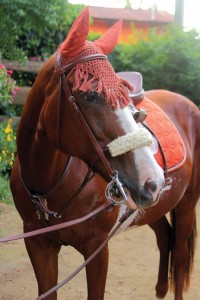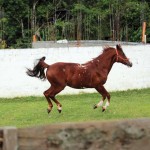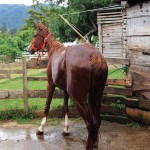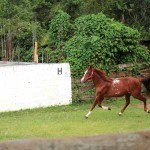Rescuing Rosie
by Kathy Jo Robbert
The chestnut mare floats in her paddock, performing a perfect passage, an advanced dressage movement performed under a rider. But this mare does it all on her own. With her diagonal legs working in perfect synchronization, lifting higher, higher, the mare celebrates the freedom of being who she is. For the first time in a long time, owing to good horse-keeping, she feels like a horse again. Is this mare the latest pricey warm blood imported from Europe, enjoying posh quarters in Guatemala City? In fact, no. She’s Rosie the workhorse, not the first equine to be rehabilitated and stabled at Ravenscroft Riding Stables in San Juan del Obispo owned by Fred and Paula Haywood.Rescuing Rosie was Terry’s mission. She had often observed with heavy heart the bony and sometimes bleeding horses foraging the skimpy grass growing along local carreteras. She had pondered the plight of thousands of little pack horses in local campos who, often without adequate food or water, are made to carry excessively heavy loads with bad equipment. What can one person do?
Enter Rosie. In April 2012, through the urging of a fellow animal lover and carriage horse benefactor, Terry heard about Rosie. Convinced by her friend that the small mare, extremely underweight and covered with open wounds from her previous jobs of hauling wood and pulling carriages, would probably die without drastic intervention, Terry bought Rosie sight unseen at a price that allowed the driver to buy a larger animal better suited to pull a carriage.
“I really thought I was going to change Rosie’s life, but she actually has changed mine, far more than what I would have expected.”
“I realized I led with my heart, not my head,” Terry said. She didn’t think in that moment about money, the time involved, or logistics. “When you work out of a place of love and service, you have an angel on your shoulder. Miracles do happen when that intention is there.”
For the time being, Rosie was kept at a finca near San Juan del Obispo while Terry figured out where to put her horse. Like most people unfamiliar with proper care and keeping of horses, she thought she could put the horse in a field on her property, figuring the mare’s life would be fine. She learned the truth when Paula Haywood explained what proper horse care involves: building fencing and adequate shelter for the horse and another for food and hay storage, installing a water system, securing and paying for horse health care like regular worming, vet care, hoof care, and dental care, as well as buying equipment. All that costs money.
Her mind now firmly grasping the true scope of the rescue project, Terry decided to board the horse at Ravenscroft Riding Stables. “I realized I was so inexperienced that Rosie would hurt me and it’d be my fault,” Terry said. “Rosie needed intensive rehabilitation and Fred and Paula were able to provide that.” She’s grateful she knows the Haywoods, who have more than 40 years of experience working with horses, including 31 in the riding stable business. The Haywoods have rehabilitated and retrained most of the horses they’ve acquired, turning them into reliable mounts, including one ex-racehorse that previously required six men to bridle.
Terry said she’d wake up at 2 a.m., worrying about the huge rehabilitation project that she had just taken on.
Could she follow through with her commitment? Where would the money come from? But in a moment of clarity she remembered what happened to her while rescuing cats and dogs. “If I’m committed and working from the heart, in some way help would appear and it would all be okay.”
Rosie is now up to her ideal weight of 800 pounds, all abscesses are healed, hoofs maintained, and she’s in prime muscled condition.
At seeing Rosie for the first time, stable owner Paula felt “utterly dismayed” at observing the extremely emaciated mare with a roach back, a conformation defect in which the horse’s spinal column arches upward rather than downward. Rosie had 17 open wounds and white hair grown over former injuries. Extremely undernourished, Rosie weighed in at 650 pounds. Her head appeared too big for her body, she had a “ewe” neck (an extremely thin and underdeveloped neck giving an upside down appearance).
But the needed physical rehabilitation was easy compared to the horse’s deeper emotional wounds—Rosie was afraid of people. “She was behaving viciously, biting and kicking because she’d been abused,” said Paula. “I had a huge green, black, orange, and purple bruise to prove it.” A new cross-tie area had to be built for the safety of the handlers. Rosie had to be bribed with bananas so her eyes and nostrils could be cleaned. Fred got kicked three times, and that doesn’t include the times Rosie missed him.
Also, Rosie didn’t know anything about carrying a rider, her new work that started within several months after arriving at Ravenscroft. “She wanted to take off all the time. She didn’t understand a thing about control. One hundred times I had to stop her from running off, just in one two-hour ride,” said Fred. “It tries your patience, believe me!” He says that quiet handling, persistence, and patience are keys in retraining. Both he and Paula develop horses who become willing partners in riding for pleasure.
Rosie got what she needed at Ravenscroft—quiet, consistent handling and round-the-clock care, with no days off. The stable’s policy of patience, persistence, and respect for the horse instead of the violent and often cruel “I’ll show them who is boss” approach has paid off. Rosie now allows her ears and nostrils to be touched during grooming minus the cross-ties, and she doesn’t kick as much. “A soft answer turns away wrath! You do something nice to them and then they think it is okay,” said Paula.
Eating the best hay available, horse concentrate, boiled linseed and banana-carrot-apple and sweet potato treats, Rosie gained 150 pounds in four months. She suffered a setback in November when she had to fight a bout of colic, a sometimes fatal impaction of the intestines. A vet was called in, who in the process of examining Rosie declared her (erroneously) to be pregnant. Terry again was staying awake at 2 a.m. Not another mouth to feed! “Rosie always had a big belly since we got her, so she could have been pregnant, but now that seems just how she is,” said Paula. “She recovered from the colic and we never had any trouble since.”
Paula is surprised by the little wood-carrying work mare’s talent and how quickly she has caught on. Rosie is now used and available for riding lessons and trail rides, and she can jump small obstacles. “When we let her loose, she floats about like a champion,” said Paula adding, “she has a very bold, forward going attitude and will go anywhere and do anything we ask of her, without resistance.”
Terry is surprised too. “I really thought I was going to change Rosie’s life, but she actually has changed mine, far more than what I would have expected.” Terry, who didn’t initially take on the project with the intention of learning to ride, started taking private lessons with Paula and recently bought a new bridle, saddle pad, and a fly bonnet for Rosie, all to match her chestnut color. “She takes me to another world. I feel like Rosie and I are dancing together.” Terry says she’s organized her life so she has more time to be with Rosie.
The totally transform-ed Rosie is now up to her ideal weight of 800 pounds. All abscesses are healed, hoofs maintained, and she’s in prime muscled working condition. The kicking and biting has subsided, and she’s accepting the human touch. “She’s responded beautifully, and given her history, that’s miraculous,” said Terry.
Would she do another horse rescue? Terry explains that despite the reward of seeing a horse thrive, due to the financial commitment and time involved, Rosie is her one and only. She says would-be rescuers need to be committed to the animal for the rest of its life, especially in the case of horses, where a sale is often the beginning of a downward spiral. If the would-be rescuer is not a horse expert, he or she needs to be willing to pay for experienced people to do the rehab.
But those with funds can have a rewarding experience. Terry concluded, “I accomplished what I wanted to accomplish. I love to be with her. That she’s no longer suffering, that’s the bottom line, and not only that, she’s prospering.”



